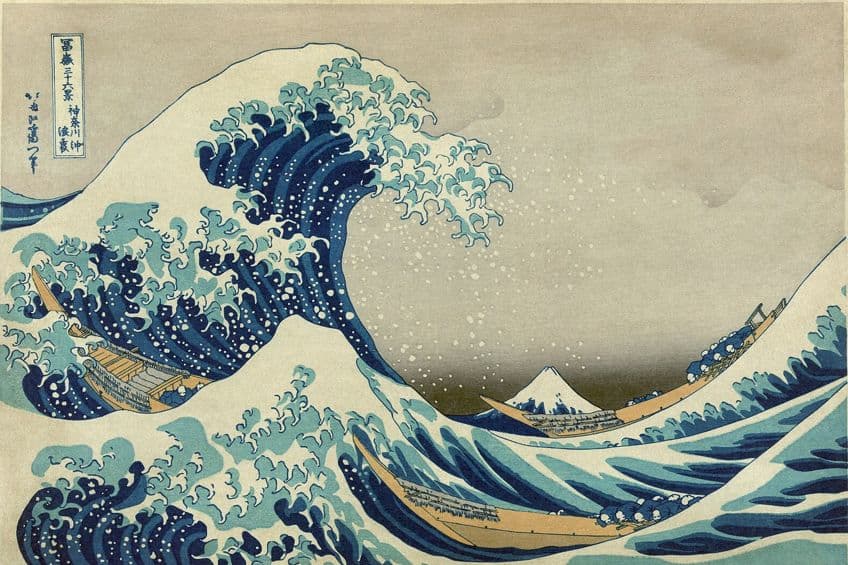“The Great Wave Off Kanagawa” by Katsushika Hokusai – Analysis
The famous Japanese artist, Katsushika Hokusai, produced The Great Wave painting and is regarded as one of the greatest painters, woodblock printmakers, and book illustrators in Japan. The famous wave painting is part of a series of Hokusai paintings titled Thirty-Six Views of Mount Fuji and was completed in 1831. But, when was The Great Wave Off Kanagawa made, and where is The Great Wave Off Kanagawa by Katsushika Hokusai today? In the article below, we will answer these questions related to the famous wave painting and look at The Great Wave Off Kanagawa‘s meaning.
The Great Wave Off Kanagawa by Katsushika Hokusai
| Artist | Katsushika Hokusai (1760 – 1849) |
| Date Completed | 1831 |
| Medium | Woodblock print |
| Dimensions (cm) | 25 x 37 |
| Location | Multiple prints in museums across the world |
The Great Wave painting’s composition is a combination of the traditional prints found in Japan and the application of graphical perspective pioneered in Europe, and it garnered him instant recognition in his home country of Japan and then subsequently in Europe, where the famous Japanese artist influenced the works of the Impressionists. Many museums worldwide own copies of The Great Wave painting, a number of which originated from private collectors of Japanese prints in the 19th century. It is ranked by many people as the most famous Japanese artwork and has been replicated, reproduced, and satirized in innumerable iterations.
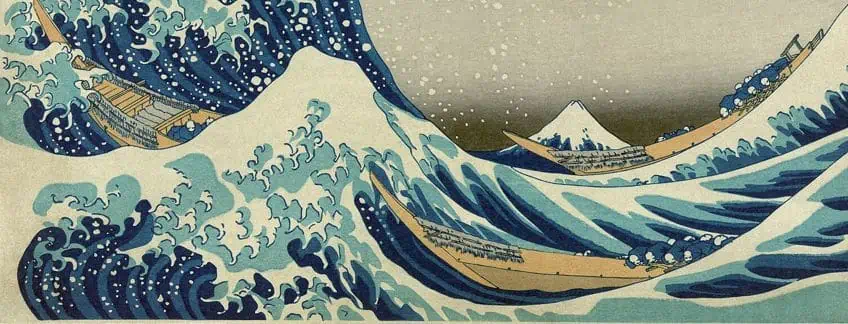
Background of The Great Wave Off Kanagawa by Katsushika Hokusai
Hokusai’s paintings are created using a process known as Ukiyo-em which is a centuries-old Japanese printmaking technique. Its artists created woodblock prints of kabuki players, beautiful women, sumo wrestlers, scenes from Japanese folk stories and history, landscapes, travel scenes, Japanese fauna and flora, and erotica, among other topics.
In 1603, after the city of Edo became the seat of power of the Tokugawa shogunate, the city’s craftsmen, merchants, and workers reaped the greatest benefits from its rapidly increasing economic growth and started participating in and patronizing the pleasures of kabuki theater, geishas, and districts courtesans.
Ukiyo-e Artworks
The word ukiyo was used to define this hedonistic way of living. Ukiyo-e works were either printed or painted and grew in popularity among those who accumulated enough income to decorate their houses with them. Hishikawa Moronobu’s paintings and monochrome prints of ladies were among the first ukiyo-e artworks to appear in the 1670s. Color prints emerged gradually and were initially reserved for special projects.

Artists like Okumura Masanobu had begun employing multiple woodblocks in order to print different sections of color by the 1740s. The rise in popularity of the brocade prints by Suzuki Harunobu in the 1760s led to full-color manufacturing becoming commonplace, with every print requiring 10 or more blocks to produce a picture. Some ukiyo-e artists also focused on painting, although the majority of their artworks were prints. Because printing was done by hand, artists were able to produce effects that machines could not, such as color gradation or mixing on the printing block.
Introduction to the Famous Japanese Artist Katsushika Hokusai
Katsushika Hokusai was born in 1760 in Katsushika, Japan, a region east of Edo. Hokusai was believed to be the son of a shogun mirror maker, and because he was never officially acknowledged as an heir, his mother is thought to most likely have been a concubine. Hokusai first started painting at the age of six, and when he was 12 years of age, his father put him to work at a bookshop. He then became an apprentice to an engraver at the age of 16, where he stayed for three years while simultaneously learning how to make his own style of illustrations.
Hokusai was then chosen to be the apprentice of Katsukawa Shunsh, regarded as one of the best ukiyo-e artists of his era when he was 18 years old.
When Shunsh passed away in 1793, Hokusai went on to study other Chinese and Japanese styles, in addition to some French and Dutch artworks. In 1800, he started to take on trainees, and it was during this time that he started using the name Hokusai; he would employ more than 30 aliases throughout his lifetime. Hokusai started to gain even more attention in 1804 when he made a 240-square-meter illustration of a Buddhist monk called Daruma for an Edo festival. He published the first of 15 volumes of drawings of things that fascinated him in 1814, including animals, people, and Buddha. In the last years of the 1820s, he released the acclaimed Thirty-six Views of Mount Fuji series of prints.
Description of the Famous Wave Painting
This famous Japanese artwork was produced using the ukiyo-e printing technique in a landscape format. The main elements of the painting are the ocean, the boats, and the mountain in the background. At the top corner is Hokusai’s signature.
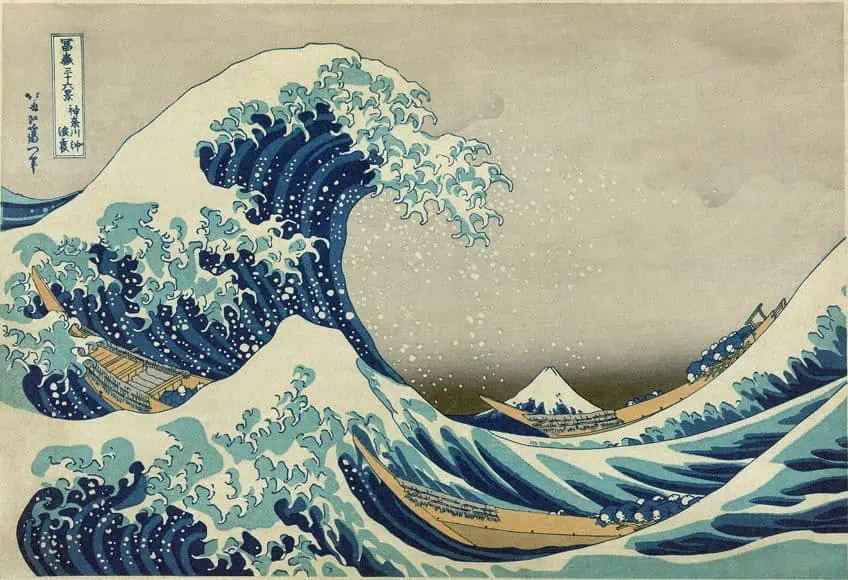
The Mountain
Mount Fuji and its snow-capped peak are visible in the background, and it is the principal character in a series of Hokusai paintings depicting the mountain from various viewpoints. Mount Fuji is portrayed in blue with white accents in The Great Wave painting, comparable to the foreground wave. The dark color around Mount Fuji suggests the picture takes place in the early morning, with the sun rising from the vantage point of the viewer and slowly starting to brighten the snow-filled apex.
There are clouds between the viewer and the mountain; yet, there is no rain on the mountain or in the main landscape, despite the fact that these clouds typically signify a storm.
The Boats
The image depicts three rapid boats used to deliver live fish from the Boso and Izu peninsulas to Edo Bay marketplaces. According to research, the boats in the painting are depicted in Edo Bay, off the coast of Yokohama, with Mount Fuji to the west and Edo to the north. The boats are heading south, most likely to Sagami Bay, where they will pick up a load of fish for trade in Edo. Eight rowers hold on to their oars in each boat in the painting. Using the boats in the painting as a reference, the height of the wave can be estimated to be around 12 meters high.

The Waves and Sea
The water takes center stage in this composition, which is based on the shape of a wave that extends out, dominating the entire landscape before breaking. The wave now forms an exact spiral with its center crossing through the design’s center, enabling viewers to observe Mount Fuji in the artwork’s background. The image is composed of a multitude of curves, with the water’s surface serving as an extension of the waves’ inner curves.
The foamy curves of the biggest wave produce additional curves, which split into numerous little waves.
The wave is typically described as being created by a tsunami, but it is sometimes also depicted as a monster or ghostly wave frightening the fisherman with its foamy “claws”. This interpretation of the Great Wave painting is reminiscent of Hokusai’s command of Japanese fantasies demonstrated by the specters seen in his Hokusai Manga. This famous wave painting is reminiscent of several of Hokusai’s prior paintings, which represent supernatural themes more explicitly. The silhouette of the wave is similar to that of a dragon, which the artist often depicted, even on Mount Fuji itself.

Creation of the Great Wave Painting
During the composition of this famous wave painting, Hokusai encountered many challenges. He experienced financial difficulties in 1826, when in his 60s, and a significant medical problem, most likely a stroke, in 1827. His wife then passed away in 1828, and the following year, he had to help out his grandson from financial difficulties, ultimately plunging Hokusai into destitution. His financial difficulties lasted for several years, during which time he worked on his renowned Mount Fuji series. According to some scholars, the series’ objective appears to have been to portray the dichotomy between the holy Mount Fuji and profane society.
The painting’s final design was created in late 1831, after several years of attempts at numerous potential designs.
The Great Wave painting exhibits Hokusai’s sketching skills, and the print, while seemingly simple to the observer, is the result of an extended period of careful reflection. In 1812, Hokusai laid the groundwork for his method of painting, claiming that any object can be depicted utilizing the relationship between the square and the circle. Hokusai revisited the wave concept a few years later when he published the second book of his Mount Fuji views. This print has the same wave-mountain interaction as the previous one, as well as the same explosion of foam. In this later painting, though, there are no boats or humans present.

How the West Influenced the Famous Wave Painting
In the 18th century, perspective prints emerged in Japan. These prints use a single-point perspective instead of the typical background, foreground, and middle-ground viewpoint that Hokusai regularly rejected. Objects in classical Japanese painting and Far Eastern artworks, in general, were not painted in perspective; instead, the proportions of objects and humans were decided by the value of the topic within the setting, as was also the case in ancient Egypt. Perspective, which was originally utilized in Western art by Piero della Francesca and Paolo Uccello, was brought to Japanese painters by Western merchants settling in Nagasaki, mainly Dutch merchants.
As early as 1750, artists such as Okumura Masanobu, and particularly Utagawa Toyoharu, attempted to replicate the practice of Western perspective, creating engravings that portrayed the Venetian canals or the ancient Roman ruins in perspective.
Toyoharu’s art had a significant impact on landscape painting in Japan, which expanded with the paintings of Hiroshige – a distant pupil of Toyoharu via Toyohiro – as well as Hokusai. In the 1790s, Hokusai grew familiar with the Western perspective through Shiba Khan’s studies from whose teaching he gained much knowledge. When Western students first discover Japanese prints, they nearly always lean toward the late masters Hiroshige and Hokusai as the apex of Japanese artwork, without recognizing that part of what they adore is an unconscious affinity they feel to their own Western traditions. Ironically, it was the appreciation of the Impressionists and Post-impressionists for Hiroshige and Hokusai’s art that helped to rejuvenate Western painting near the end of the 19th century.
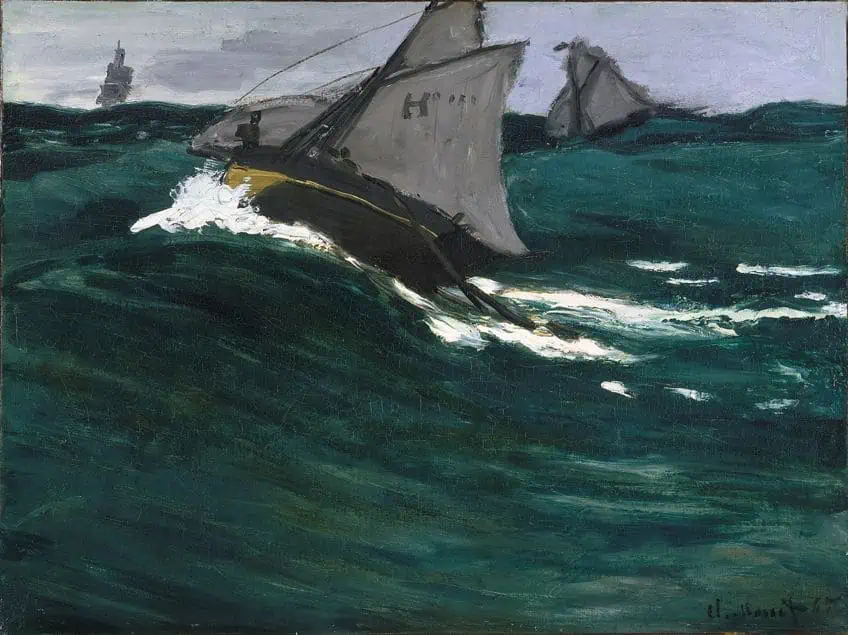
The Blue Revolution in Japan
Hokusai’s paintings and prints experienced a “blue revolution” in the 1830s when he extensively used the dark-blue color Prussian blue. For The Great Wave painting, he utilized this shade of blue instead of indigo, a delicate, swiftly fading hue of blue that was often employed in ukiyo-e paintings of the period. Prussian blue was an import from Holland that emerged in 1820 and was used extensively by Hokusai.
The first 10 prints in the series, including the famous wave painting, were among the first prints in Japan to make use of Prussian blue, which was probably recommended to the publisher around 1830, and it was an instant success.
How the Painting Influenced the West
Following the Meiji Restoration in 1868, Japan ended a long era of seclusion and opened its doors to Western goods. As a result, a considerable amount of Japanese art was brought to America and Europe, where it soon became popular. Japonism refers to the impact of Japanese art on the West. Japanese woodblock prints influenced many Western painters, notably the Impressionists. The Great Wave painting, as the most renowned Japanese print, impacted great works: in art, it significantly influenced artworks by Claude Monet; in music, it had an impact on musicians such as Claude Debussy; and even in literature, Rainer Maria Rilke’s Der Berg makes reference to this famous artwork.
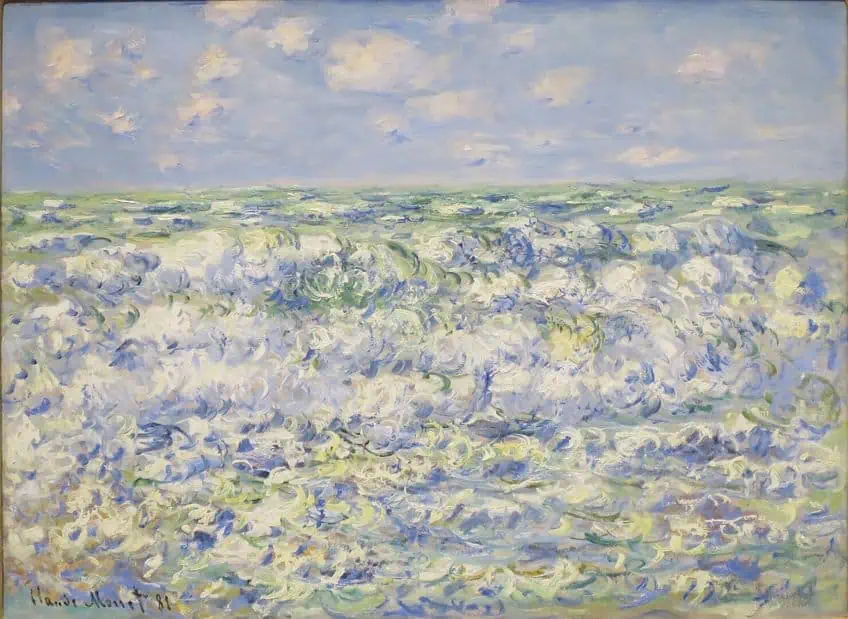
Claude Debussy kept a copy of the famous wave painting in his studio because he loved the ocean and created scenes of the Far East. He was motivated by the print while working on La Mer and requested that it be placed on the cover of the official 1905 score. Henri Riviére, an engraver, draftsman, and watercolorist who also played a key role in the establishment of the famous Paris nightclub Le Chat Noir, was one of the first painters to be profoundly impressed by Hokusai’s artwork, most particularly the famous wave painting. Riviére released a series of 36 lithographs of the Eiffel Tower in 1902 as a tribute to Hokusai’s artwork. Vincent van Gogh, a big fan of Hokusai, praised the work of art’s use of line, writing that it had a “terrifyingly emotional impact” on him.
Interpretation of The Great Wave off Kanagawa by Katsushika Hokusai
What is The Great Wave Off Kanagawa’s meaning? The massive wave is sometimes viewed as a symbol of the ocean’s overwhelming strength and capacity to consume humanity. It personifies the sublime, inspiring both awe and dread in the face of the forces of nature. The contrast between the rising wave and the seemingly perpetual prominence of Mount Fuji in the background depicts the brief nature of our existence. The approaching battering of the wave and the fragility of the boats further allude to the fleeting aspect of human existence.
The artwork illustrates Japan’s connection with the ocean as well as its reliance on the sea for subsistence and commerce.
It also embodies the essence of the Ukiyo-e genre, depicting scenes from daily life, entertainment, and nature. In Japanese culture, Mount Fuji is a cherished and beloved symbol of permanence, stability, and spiritual enlightenment. Its tranquil presence amidst the violent surf acts as a counterpoint, stressing the natural world’s balance and eternal character. The painting’s mix of Eastern and Western aesthetic traditions indicates Japan’s expanding exposure to foreign cultures throughout the Edo era.
Interesting Facts About the Great Wave Painting
That almost wraps it up for this article on The Great Wave Off Kanagawa by Katsushika Hokusai. However, before we go, we would like to share a few interesting facts about the famous great wave painting. After that, we will answer a few frequently asked questions regarding this famous Japanese artwork.

It Took Years for International Recognition
This famous Japanese artwork was most likely first printed sometime between the years 1829 and 1832, although at that period of time, Japan’s cultural engagement with other nations was limited to commerce with Korea and China, which was very rigorously controlled, and also the Dutch, who were limited to operating in Nagasaki. It would take nearly three decades for political pressures to coerce Japan to re-open its borders and export to other nations.
In 1859, a flood of Japanese prints swept throughout Europe, capturing the attention of artists such as James Abbott McNeill Whistler, Vincent Van Gogh, and Claude Monet, among countless others.
Historians and Politicians in Japan Did Not View It As Art
The print of the wave became so well-known that it became a universally recognized representation of Japanese culture and art around the world. However, as historians argue, woodblock prints were not considered art in Japan, but rather as a prevalent means of expression and printing for commerce. Woodblock prints, which originally were utilized to illustrate Buddhist texts, have become synonymous with illustrations for poetry and romances. As a result, Japanese politicians and historians expressed disappointment that such an apparently lowbrow genre of art had come to characterize them.
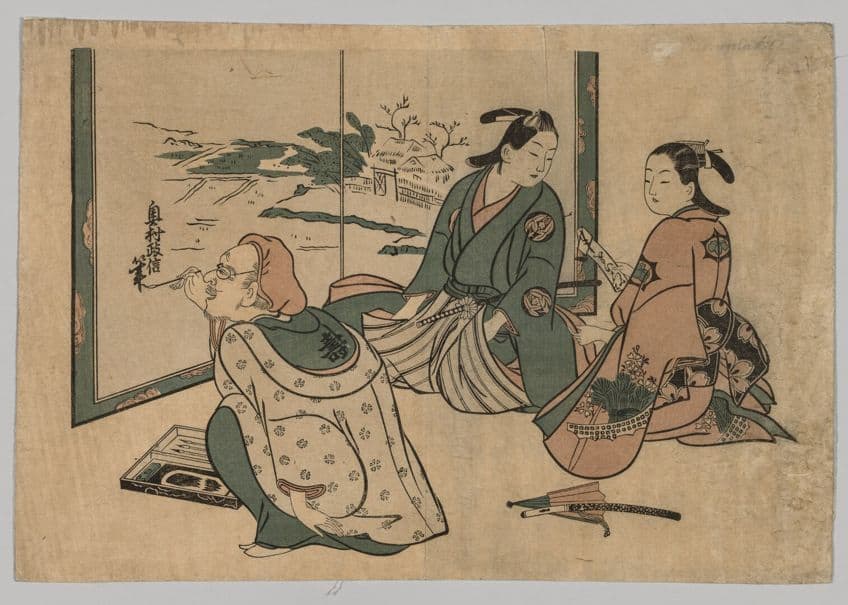
The Earliest Prints Are the Most Valuable
Despite the fact that thousands of copies of the painting were printed, it is thought that only a few hundred copies still exist. The state of a copy determines its worth. The first edition had a prominent blue outline, while the second run of prints had a black outline. The first prints are expected to bring around $40,000 to $60,000 each, while the prints with the black outlines are expected to be worth half that much. Unfortunately, the wood blocks that were used to stamp the color on the print would eventually start to break down throughout the course of the manufacturing, lowering the picture quality.
Because of this progressive deterioration, museums will boast about their prints being “early” editions, as these do not display the same degradation.
Some Say the Wave Is Not Caused by a Tsunami
Many have argued that the wave in the famous painting was the result of a tsunami. Scholars researched the print as well as what we understand concerning waves to discover that it is, in fact, a rogue wave. These types of rogue waves are sometimes also called “freak waves” because they strike unexpectedly in the open ocean, occasionally breaking ocean liners. This rogue wave can be measured owing to three fishing boats next to it and has been estimated to be around 32 feet in height.

The famous wave painting’s most striking component is the massive wave, which is about to smash into the boats with its claw-like crest, symbolizing nature’s unstoppable might and human fragility. Prussian blue, the stunning dark blue pigment employed by Hokusai, was a new substance at the time, manufactured by the Dutch and brought from England via China. Not only was the painting influenced by certain artistic breakthroughs from the West, such as perspective, but it would also subsequently influence the West in return as artists grew fascinated with everything Japanese. The Great Wave painting continues to have a huge impact both in Japan and internationally.
Frequently Asked Questions
When Was The Great Wave Off Kanagawa Made?
This famous wave painting was believed to have been made around 1829. Due to it being a woodblock, it was printed on several different occasions. The interesting thing about these prints is that their value is based on which run of prints the specific work comes from. The oldest prints are regarded as the most valuable, as the blocks used to create them had not begun to wear down yet.
Where Is The Great Wave Off Kanagawa Located?
This famous painting actually began as a woodblock print. Therefore, thousands of copies were made, of which a few hundred remain today. These copies can be found in some of the top museums in the world, such as the Art Institute of Chicago, the Metropolitan Museum of Art in New York City, the British Museum of London, and the National Gallery of Victoria in Melbourne. Claude Monet’s home is also said to possess a copy.
Jordan Anthony is a Cape Town-based film photographer, curator, and arts writer. She holds a Bachelor of Art in Fine Arts from the University of the Witwatersrand, Johannesburg, where she explored themes like healing, identity, dreams, and intuitive creation in her Contemporary art practice. Jordan has collaborated with various local art institutions, including the KZNSA Gallery in Durban, the Turbine Art Fair, and the Wits Art Museum. Her photography focuses on abstract color manipulations, portraiture, candid shots, and urban landscapes. She’s intrigued by philosophy, memory, and esotericism, drawing inspiration from Surrealism, Fluxus, and ancient civilizations, as well as childhood influences and found objects. Jordan is working for artfilemagazine since 2022 and writes blog posts about art history and photography.
Learn more about Jordan Anthony and about us.
Cite this Article
Jordan, Anthony, ““The Great Wave Off Kanagawa” by Katsushika Hokusai – Analysis.” artfilemagazine – Your Online Art Source. June 15, 2023. URL: https://artfilemagazine.com/the-great-wave-off-kanagawa-by-katsushika-hokusai/
Anthony, J. (2023, 15 June). “The Great Wave Off Kanagawa” by Katsushika Hokusai – Analysis. artfilemagazine – Your Online Art Source. https://artfilemagazine.com/the-great-wave-off-kanagawa-by-katsushika-hokusai/
Anthony, Jordan. ““The Great Wave Off Kanagawa” by Katsushika Hokusai – Analysis.” artfilemagazine – Your Online Art Source, June 15, 2023. https://artfilemagazine.com/the-great-wave-off-kanagawa-by-katsushika-hokusai/.


